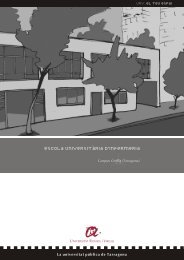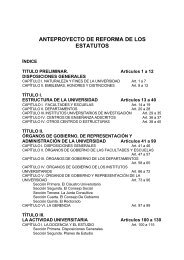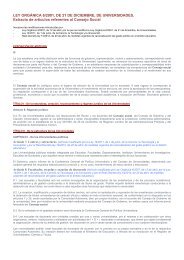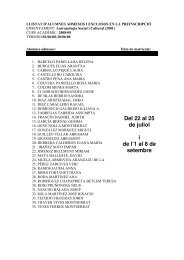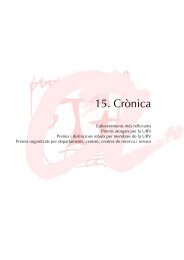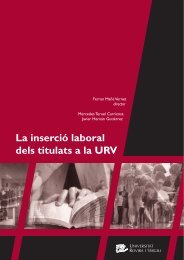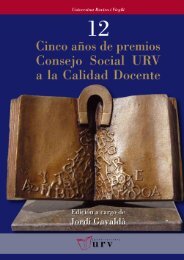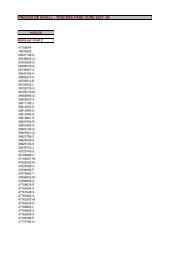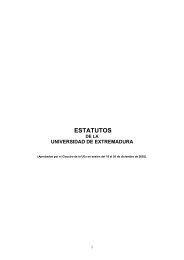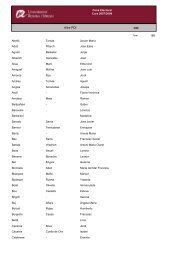The Realization of the Uvular Stop [q] in Arabic
The Realization of the Uvular Stop [q] in Arabic
The Realization of the Uvular Stop [q] in Arabic
- No tags were found...
You also want an ePaper? Increase the reach of your titles
YUMPU automatically turns print PDFs into web optimized ePapers that Google loves.
A Diachronic Phonetic and Phonological Study <strong>of</strong> <strong>the</strong> <strong>Uvular</strong> <strong>Stop</strong> [q] <strong>in</strong> <strong>Arabic</strong><br />
Author’s name: Taoufik GOUMA<br />
Affiliation: University Paris 8<br />
E-mail: Taoufik.gouma@etud.univ-paris8.fr<br />
Among <strong>the</strong> different l<strong>in</strong>guistic phenomena related to <strong>the</strong> study <strong>of</strong> <strong>Arabic</strong> l<strong>in</strong>guistics and<br />
particularly its phonology and phonetics, we f<strong>in</strong>d one related to <strong>the</strong> analysis <strong>of</strong> <strong>the</strong> uvular stop [q].<br />
This phoneme attracted <strong>the</strong> attention <strong>of</strong> early Arab grammarians as well as many orientalists and<br />
modern l<strong>in</strong>guists for <strong>the</strong> different issues related to its evolution and treatment. We are go<strong>in</strong>g to<br />
explore here two <strong>of</strong> <strong>the</strong>se.<br />
First <strong>of</strong> all we are go<strong>in</strong>g to give a diachronic analysis <strong>of</strong> this segment <strong>in</strong> early Classical <strong>Arabic</strong><br />
(CA henceforth) which is <strong>in</strong>tended to determ<strong>in</strong>e its early phonetic realization. Accord<strong>in</strong>g to <strong>the</strong><br />
descriptions <strong>of</strong> some early Arab grammarians (such as Sibawayh and Ibn J<strong>in</strong>ni) <strong>the</strong> [q] <strong>of</strong> CA had<br />
<strong>the</strong> phonetic value <strong>of</strong> [g]. Sibawayh for example describes it as majhuura (voiced) and as be<strong>in</strong>g<br />
articulated <strong>in</strong> ‘aqsā llisan wama fawqahu m<strong>in</strong>a lanak al alā’ (Al Kitāb, Vol 4, p. 433), i. e. as a<br />
velar. Follow<strong>in</strong>g Sibawayh, Ibn J<strong>in</strong>ni gives <strong>the</strong> same description when he says ‘wa mimā fawqa<br />
dālika makhraju lqāf’ (Sir Senāat al Irāb, Vol 1, p. 278). F<strong>in</strong>ally, Avicenna also describes it, <strong>in</strong><br />
his ‘’Rissāla’’, as a velar when he says that it is realized <strong>in</strong> <strong>the</strong> place <strong>of</strong> articulation <strong>of</strong> [x]. But,<br />
when we look at <strong>the</strong> analysis <strong>of</strong> Ibn yaich (Sharal Mufassal, Vol 10, p. 124) we f<strong>in</strong>d that he<br />
puts it <strong>in</strong> <strong>the</strong> same place <strong>of</strong> articulation as [k] and def<strong>in</strong>es this place as lahāt, i. e. <strong>the</strong> uvula.<br />
I show that <strong>the</strong>se descriptions run counter to <strong>the</strong> phonetic features <strong>of</strong> [q] <strong>of</strong> fusa <strong>Arabic</strong> known <strong>in</strong><br />
modern l<strong>in</strong>guistics, and <strong>in</strong> <strong>the</strong> traditional Quranic recitation, i. e. a voiceless uvular stop. Mak<strong>in</strong>g<br />
ano<strong>the</strong>r analysis <strong>of</strong> <strong>the</strong> descriptions made by <strong>the</strong> Arab grammarians, I show that <strong>the</strong> reasons<br />
beh<strong>in</strong>d this contradiction lie <strong>in</strong> our misunderstand<strong>in</strong>g <strong>of</strong> <strong>the</strong> terms used by <strong>the</strong>se last named, and<br />
not <strong>in</strong> <strong>the</strong>ir non comprehension <strong>of</strong> <strong>the</strong> manner <strong>of</strong> articulation <strong>of</strong> this segment. As an example, what<br />
Sibawayh calls ‘aqsā llisān’ is def<strong>in</strong>ed by Al Farāhidi as ‘aqsa lalq’ and by Al layth <strong>in</strong> ‘At<br />
tahdīb’ as al lahāt, i. e. <strong>the</strong> uvula.<br />
<strong>The</strong> second issue concerns <strong>the</strong> l<strong>in</strong>k that some l<strong>in</strong>guists (Cant<strong>in</strong>eau 1960, Jakobson 1957) made<br />
between <strong>the</strong> [q] and <strong>the</strong> emphatics. This l<strong>in</strong>k was done on <strong>the</strong> basis <strong>of</strong> <strong>the</strong> place <strong>of</strong> articulation <strong>of</strong><br />
this segment which is uvular, and <strong>the</strong>n guttural, which is not far from that <strong>of</strong> <strong>the</strong> secondary<br />
articulation <strong>of</strong> <strong>the</strong> emphatics, i. e. <strong>the</strong> pharynx. I will give a phonetic and acoustic analysis <strong>of</strong> <strong>the</strong><br />
[q] through which I will show that this latter cannot be considered as an emphatic, and that <strong>the</strong><br />
feature it shares with <strong>the</strong> emphatics is only acoustic. This acoustic feature is what is called <strong>in</strong><br />
<strong>Arabic</strong> l<strong>in</strong>guistics tafkhīm; a sort <strong>of</strong> grave resonance created by <strong>the</strong> shape <strong>of</strong> <strong>the</strong> oral cavity that is<br />
larger as <strong>in</strong> <strong>the</strong> emphatics. This large configuration is due, at <strong>the</strong> same time, to <strong>the</strong> back <strong>of</strong> <strong>the</strong><br />
tongue which goes up to reach <strong>the</strong> uvula and to <strong>the</strong> front part <strong>of</strong> <strong>the</strong> tongue which goes down. If<br />
[q] had <strong>the</strong> phonetic value <strong>of</strong> [g] <strong>the</strong>n Arab grammarians would not have <strong>in</strong>cluded it among <strong>the</strong><br />
mufaxxama, s<strong>in</strong>ce [g] does not have this acoustic feature.
References.<br />
- Al Nassir, A.A. 1993 ‘Sibawayh <strong>the</strong> Phonologist’ A critical study <strong>of</strong> <strong>the</strong> phonetic and phonological <strong>the</strong>ory <strong>of</strong><br />
Sibawayh as presented <strong>in</strong> his treatise Al Kitaab. Kegan Paul International Ltd.<br />
- Al Farāhīdi (1980) ‘Al ayn’, eds. Al Makhzumi et al. vols. I-IV, Baghdad.<br />
- Az Zamakhshari (1999) ‘Al Mufassal fi sanat al irāb’, ed. Yaakoub. Beyrouth, Lebanon.<br />
- Cant<strong>in</strong>eau, J. (1960) ‘Cours de phonétique arabe’ P., Kl<strong>in</strong>cksieck, Paris.<br />
- Cohen, D. (1988) ‘Les langues dans le monde ancien et moderne; les langues chamito-sémitiques’. Edition du<br />
CNRS, Paris.<br />
- Ibn J<strong>in</strong>ni (1954) ‘Sir Senāat al Irāb’, eds. Mustafa al Saqqa et al, Vol. 1. Cairo.<br />
- Ibn Sīna (1981) ‘Rissāla fī asbāb udūth al urūf’, eds. Mohammad Hassan et al, Damascus.<br />
- Jakobson, R. (1957) ‘Mufaxxama-<strong>the</strong> ‘Emphatic’ Phonemes <strong>in</strong> <strong>Arabic</strong>’, <strong>in</strong> E. Pulgram (e. d), Studies Presented<br />
to Joshua Whatmough, Mouton, pp. 105-16.<br />
- Moscati et al. (1981) ‘An Introduction to <strong>the</strong> Comparative Grammar <strong>of</strong> <strong>the</strong> Semitic Languages: phonology and<br />
morphology’. Third pr<strong>in</strong>t<strong>in</strong>g, Otto Harrassowitz. Wiesbaden.<br />
- Rab<strong>in</strong>, C. (1951) ‘Ancient Western Arabian’. London, Taylor’s Foreign Press’.<br />
- Sibawayh. (1975) ‘Al Kitaab’ 4 vols. Ed. A.S.M. Harun, Cairo.


![The Realization of the Uvular Stop [q] in Arabic](https://img.yumpu.com/36141960/1/500x640/the-realization-of-the-uvular-stop-q-in-arabic.jpg)
